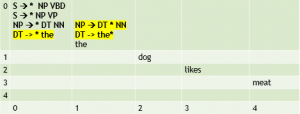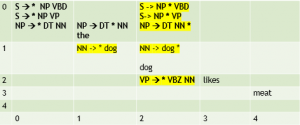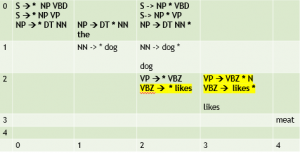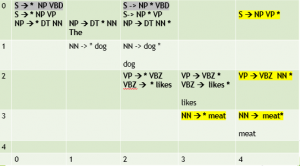Appendix: Top Down Chart Parsing
Top-down chart parsing methods, such as Earley’s algorithm, begin with the top-most nonterminal and then expand downward by predicting rules in the grammar by considering the rightmost unseen category for each rule. Compared to other search-based parsing algorithms, top-down parsing can be more efficient, by eliminating many potential local ambiguities as it expands the tree downwards[1]. Figure A1 provides the processing rules for Earley’s algorithm. Figure A.2 provides pseudocode for the algorithm, implemented as dynamic programming.
|
To illustrate a top down chart parse, we will assume the CFG shown in Figure A.3.
|
|
Figure A.4 shows a trace of a top-down chart parse of the sentence “The dog likes meat.”, showing the edges created in the top-down chart parser implemented in NLTK. The parse begins with top-down predictions, based on the grammar, and then begins to process the actual input, which is shown in the third row. As each word is read, there is a top-down prediction followed by an application of the fundamental rule. After an edge is completed (such as the first NP) then new predictions are added (e.g., for an upcoming VP).
 |
[0:0] S → * NP VBD [0:0] S → * NP VP |
For each of the sentence rules, make a top-down prediction to create an empty, active edge. |
 |
[0:0] S → * NP VBD [0:0] S → * NP VP [0:0] NP → * DT NN |
Make more top-down predictions to create active edges for each of the nonterminal categories just to the right of the dot. |
 |
[0:0] S → * NP VBD [0:0] S → * NP VP [0:0] NP → * DT NN [0:0] DT → * the [0:1] DT → the * [0:1] NP → DT * NN |
Predict the and use the fundamental rule to create new edges where the dot in the DT rule and in NP rule move to the right. |
 |
[0:0] S → * NP VBD [0:0] S → * NP VP [0:0] NP → * DT NN [0:0] DT → * the [0:1] DT → the * [0:1] NP → DT * NN [1:1] NN → * dog [1:2] NN → dog * [0:2] NP → DT NN * [0:2] S → NP * VBD [0:2] S → NP * VP [2:2] VP → * VBZ NN |
Predict dog; apply fundamental rule and then make a top down prediction for a VP (using the second S rule.)
|
 |
[0:0] S → * NP VBD [0:0] S → * NP VP [0:0] NP → * DT NN [0:0] DT → * the [0:1] DT → the * [0:1] NP → DT * NN [1:1] NN → * dog [1:2] NN → dog * [0:2] NP → DT NN * [0:2] S → NP * VBD [0:2] S → NP * VP [2:2] VP → * VBZ NN [2:2] VBZ → * likes [2:3] VBZ → likes * [2:3] VP → VBZ * NN |
Predict likes; apply the fundamental rule to create VBZ-> likes *, and again, to add VP -> VBZ * NN |
 |
[0:0] S → * NP VBD [0:0] S → * NP VP [0:0] NP → * DT NN [0:0] DT → * the [0:1] DT → the * [0:1] NP → DT * NN [1:1] NN → * dog [1:2] NN → dog * [0:2] NP → DT NN * [0:2] S → NP * VBD [0:2] S → NP * VP [2:2] VP → * VBZ NN [2:2] VBZ → * likes [2:3] VBZ → likes * [2:3] VP → VBZ * NN [3:3] NN → * meat [3:4] NN → meat* [2:4] VP → VBZ NN * [0:4] S → NP VP * |
Predict meat apply the fundamental rule for meat as a noun (NN) and again to extend the active VP edge, to get VP -> VBZ NN *. Finally, use the fundamental rule to extend the active S edge, which is now complete.
|
- Bottom-up chart parsing algorithms, as we discussed in Chapter 4, do have some advantages. For example, bottom-up methods can use rules annotated with probabilities or semantics, and then propagate values up from the leaf to the root for each subtree. ↵

